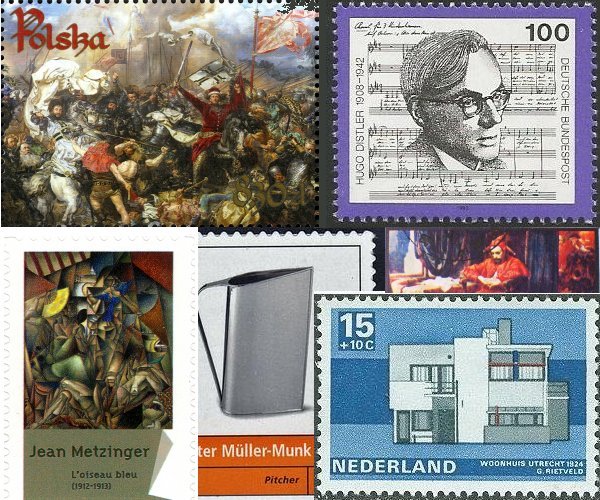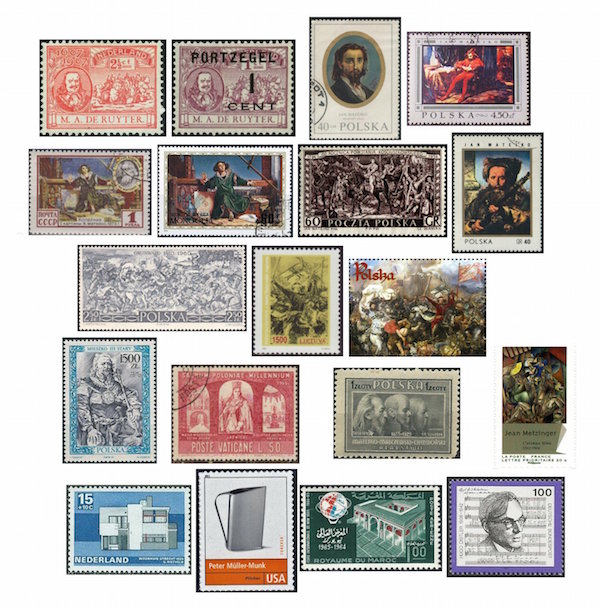The Arts on the Stamps of the World — June 24
An Arts Fuse regular feature: the arts on stamps of the world.

By Doug Briscoe
Three consecutive painters get us started today, then it’s on to a Dutch architect, a German-American industrial designer, and a German composer who committed suicide during World War II.
Dutch artist Ferdinand Bol (24 June 1616 – 24 August 1680) had the good fortune (as well as the talent, of course) to be taken on as an apprentice by Rembrandt, whose style strongly influenced the younger man’s work, even to the extent that in the 19th century a number of Bol’s works were incorrectly attributed to the Master. Bol opened his own studio in 1641, and one of his students was Godfrey Kneller. One of Ferdinand Bol’s works is his 1667 portrait of Dutch admiral Michiel de Ruyter (1607–1676), which was used for a 1907 (!) stamp design honoring the naval hero. I know of no other stamps of Bol’s work. Here’s a link to a self-portrait dated c1669.
If the number of postage stamps is any indication, Jan Matejko (June 24, 1838 – November 1, 1893) is a great favorite among Polish art lovers. He is particularly known for his sweeping historical paintings. Matejko saw a bit of history in the making himself: his brothers went off to take part in the 1846 Kraków revolution and were present at the Austrian siege of 1848; one brother was killed, the other exiled. Matejko himself was unable to join in the January Uprising of 1863 as his health wasn’t up to it, but he did donate his savings to the cause and was directly involved with providing arms to the insurgents. He had not always been so affluent—in fact, he was the quintessential “starving artist” in his young days. No scholastic paragon, he got poor grades and was never able to learn a foreign language, but artistic talent he had aplenty. He studied in Kraków and, on scholarships, in Munich and, very briefly, just a few days, actually, in Vienna. One of his earliest masterpieces, though not immediately recognized as such, was Stańczyk (The Jester, 1862, at upper right in our collage). Success came with his Rejtan (1867), which took a gold medal at the Paris World Exhibition and the Union of Lublin (1867-69), which garnered him the Légion d’honneur. Some of Matejko’s other paintings that have made their way onto stamps include (second row) The Astronomer Copernicus, Conversation with God (1872), seen on issues from both Russia and Mongolia, Battle of Racławice (1888), and Hetman Ostafi Daszkiewicz (1874). I found three stamps (third row) for his Battle of Grunwald (1878), two from Poland and one (just a tiny detail showing the central figure, Vytautas the Great) from Lithuania. Also enormously popular among the Poles is the series of drawings he made between 1890 and 1892 of all the Polish monarchs. Though many of these “portraits” are purely the product of Matejko’s imagination, they have in many cases become the standard portrayals. I show just one of these, the picture of Mieszko III “the Old” (c1126/27–1202), from an extended Polish stamp series, and a design from Vatican City of Queen Jadwiga, part of a set commemorating 1000 years of Christianity in Poland. Finally, Matejko is foremost along with Jacek Malczewski and Józef Chełmoński on a 1947 stamp honoring the three Polish artists.
For a painter and theorist of such importance as Jean Metzinger (24 June 1883 – 3 November 1956) there is a paucity of stamps, well, actually, just one. Metzinger, also a critic and poet, contributed significantly to the theory of Cubism as well as painting many canvases representative of the movement. One such, The Blue Bird (1912-13), is seen on the French stamp from 2010. There’s a fascinating connection with, believe it or not, quantum mechanics—physicist Niels Bohr kept Metzinger’s “mobile perspective” painting Woman with a horse (La Femme au Cheval, 1911–12) on the wall of his office for inspiration.

Our next two artists were both designers, the first primarily a furniture designer and also an architect, the second having founded his own industrial design firm. The former artist is Utrecht-born Gerrit Rietveld (24 June 1888 – 25 June 1964), who was for a time a proponent of the Dutch De Stijl artistic movement until breaking with it in 1928. Perhaps his career in furniture design was to some extent preordained by the fact that his father was a joiner. Young Gerrit also worked as a draftsman and jeweler and taught himself drawing, painting, and model-making. He opened his own furniture workshop in 1917, the year that saw the creation of his Red and Blue Chair. In 1923, Walter Gropius invited Rietveld to show his work at the Bauhaus. The next year, Rietveld built one of his most important creations, the Rietveld Schröder House (shown on the stamp). Today it’s a UNESCO World Heritage Site.
The German designer Peter Müller-Munck (1904–1967) was born in a wealthy suburb of Berlin. He studied silversmithing and came to the United States in 1926 to work at Tiffany’s. Three years later he had his own New York studio. In 1935 he became head of industrial design at the Carnegie Institute of Technology, where he remained until 1944, despite having established his own office in Pittsburgh in 1938. This was Peter Muller-Munk—minus the umlaut and letter “c”—Associates, which would develop the 1937 Waring blender. But Muller-Munk’s most famous design was the Normandie Pitcher, as seen on the stamp, produced between 1935 and 1941. In 1964, the company was hired by U.S. Steel to work on the Unisphere for the New York World’s Fair. I add a Moroccan stamp of that period showing the Unisphere and that event’s Moroccan Pavilion.
June 24 is also the birthday of German composer Hugo Distler (1908–1942), who wrote mostly choral music, along with two concertos, chamber and piano and organ works, etc. He joined the Nazi party with reluctance in 1933 so that he could keep his job as church organist in Lübeck. Perhaps because of his party affiliation, he was subsequently named to a number of posts as lecturer, choir director, and finally conductor of the Berlin State and Cathedral Choir, all this despite condemnation of his music by some Nazis as “degenerate.” Allied bombing raids, the deaths of friends, and fear of conscription into the Wehrmacht led Distler to commit suicide on November 1, 1942.
It is with a heavy heart and downcast mien that I report the appalling absence of a stamp for Ambrose Bierce (June 24, 1842 – circa 1914). French New Wave director Claude Chabrol (24 June 1930 – 12 September 2010) may get a stamp someday, but it’s a little early yet.
Meanwhile, happy birthday to the fine Indian writer Anita Desai (born 24 June 1937), who is also Professor of Humanities at MIT.
A graduate of the University of Massachusetts with a B.A. in English, Doug Briscoe worked in Boston classical music radio, at WCRB, WGBH, and WBUR, for about 25 years, beginning in 1977. He has the curious distinction of having succeeded Robert J. Lurtsema twice, first as host of WGBH’s weekday morning classical music program in 1993, then as host of the weekend program when Robert J.’s health failed in 2000. Doug also wrote liner notes for several of the late Gunther Schuller’s GM Recordings releases as well as program notes for the Boston Classical Orchestra. For the past few years he’s been posting a Facebook “blog” of classical music on stamps of the world, which has now been expanded to encompass all the arts for The Arts Fuse.
